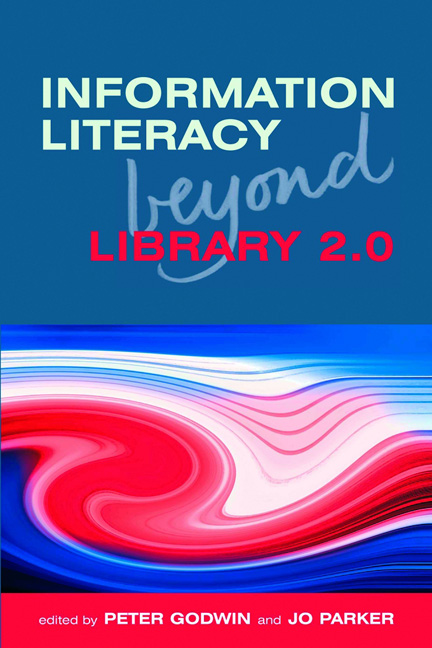Book contents
- Frontmatter
- Contents
- Contributors
- Acknowledgements
- Introduction
- PART 1 RECENT DEVELOPMENTS IN INFORMATION LITERACY AND LIBRARY 2.0
- PART 2 CASE STUDIES
- PART 3 WHAT IT MEANS FOR INFORMATION PROFESSIONALS
- 18 Helping the public online: Web 2.0 in UK public libraries
- 19 Change has arrived at an iSchool library near you
- 20 Information literacy: a path to the future
- 21 Thoughts about the future
- 22 Last word: information literacy beyond Library 2.0
- Index
20 - Information literacy: a path to the future
from PART 3 - WHAT IT MEANS FOR INFORMATION PROFESSIONALS
Published online by Cambridge University Press: 09 June 2018
- Frontmatter
- Contents
- Contributors
- Acknowledgements
- Introduction
- PART 1 RECENT DEVELOPMENTS IN INFORMATION LITERACY AND LIBRARY 2.0
- PART 2 CASE STUDIES
- PART 3 WHAT IT MEANS FOR INFORMATION PROFESSIONALS
- 18 Helping the public online: Web 2.0 in UK public libraries
- 19 Change has arrived at an iSchool library near you
- 20 Information literacy: a path to the future
- 21 Thoughts about the future
- 22 Last word: information literacy beyond Library 2.0
- Index
Summary
Introduction
We can no longer think just in terms of 2.0. Its transformation into social media and merger with mobile devices require librarians to look right across the information landscape for the literacies that are required in the future. This has been a journey of discovery for me: for the first time many things have begun to make sense, and I want to share that vision with you. I hope that you last the whole journey and do not lapse into sleep and swerve dangerously into the ditch on the way!
I believe we have to survey the whole information landscape if we are to understand the complex blend of literacies that we, as educators, and our students, as learners and 21st-century citizens, have to experience. Many writers have attempted to do this. As we go through some of these explorations we may see occasional shafts of light through the trees and clearings along the way, before we grasp that what we see keeps subtly changing and will always depend on the context.
A confusion of literacies
In recent years there have been a number of attempts to create maps of literacies, and this has sometimes implied that information literacy (IL) is no longer the central literacy for the 21st century. Twenty-first-century literacy is ‘the set of abilities and skills where aural, visual, and digital literacy overlap’ (New Media Consortium, 2005). As we have seen already, literacies can be divided into three main types: generic, situated and transforming. From the first type, Bawden (2001) traced a variety of skill-based literacies that fitted the requirements of the more varied information environment with its new technologies. This included the development of computer and, later, ICT literacy, which initially was frequently confused with IL. I will now briefly outline some of these literacies.
Digital literacy (DL)
This is ‘the ability to understand and use information in multiple formats from a wide variety of sources when it is presented via computers’ (Gilster, 1997). Gilster's view of DL went wider than the internet, which he saw as only one major digital source. It was more about literacy in the digital age. Discussions about IL and DL have not impinged much on the library practitioner (Bawden, 2001).
- Type
- Chapter
- Information
- Information Literacy Beyond Library 2.0 , pp. 229 - 240Publisher: FacetPrint publication year: 2012

